
John William Waterhouse was an English painter known for working first in the Academic style and for then embracing the Pre-Raphaelite Brotherhood's style and subject matter. His paintings are known for their depictions of women from both ancient Greek mythology and Arthurian legend. A high proportion depict a single young and beautiful woman in a historical costume and setting, though there are some ventures into Orientalist painting and genre painting, still mostly featuring women.

Frederic Leighton, 1st Baron Leighton,, known as Sir Frederic Leighton between 1878 and 1896, was a British Victorian painter, draughtsman, and sculptor. His works depicted historical, biblical, and classical subject matter in an academic style. His paintings were enormously popular and expensive, during his lifetime, but fell out of critical favour for many decades in the early 20th century.
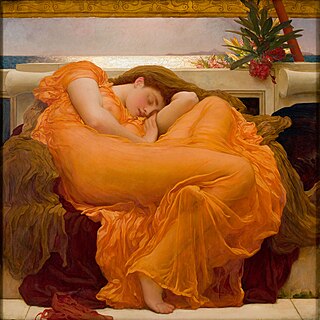
Flaming June is a painting by Sir Frederic Leighton, produced in 1895. Painted with oil paints on a 47-by-47-inch square canvas, it is widely considered to be Leighton's best-known work in the 21st century, much reproduced in posters and the like. It shows a sensuous version of his classicist Academic style. It is thought that the woman portrayed alludes to the figures of sleeping nymphs and naiads the Greeks often sculpted.
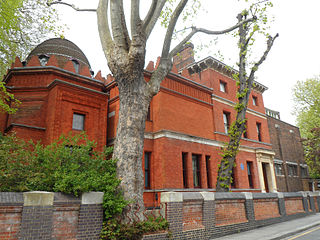
The Leighton House Museum is an art museum and historic house in the Holland Park area of the Royal Borough of Kensington and Chelsea in west London.
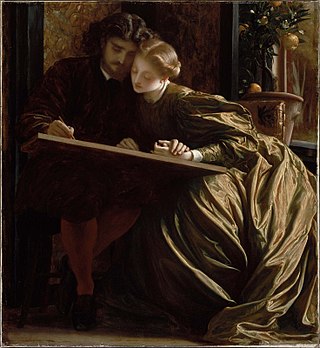
The Painter's Honeymoon is an oil painting on canvas by the English painter Frederic Leighton, 1st Baron Leighton, produced c. 1864 and now in the Museum of Fine Arts, Boston.

Cimabue's Celebrated Madonna, originally called Cimabue's [Celebrated] Madonna [is] Carried in Procession through the Streets of Florence, is an oil painting by English artist Frederic Leighton. Measuring more than two metres tall and more than five metres wide, the canvas was painted by Leighton from 1853 to 1855 in Rome as his first major work.

Cymon and Iphigenia is an oil on canvas painting by Frederic Leighton, 1st Baron Leighton. The painting does not bear a date but was first exhibited at the Royal Academy of Arts, London, in 1884. The Art Gallery of New South Wales in Sydney, Australia, purchased it at a Christie's auction in London in 1976.

"Der Fischer" is a ballad by Goethe, written in 1779. Goethe's poem describes an exchange between a fisher and a mermaid who accuses him of luring her brood. As revenge, she enchants him with her song and pulls him into the water.
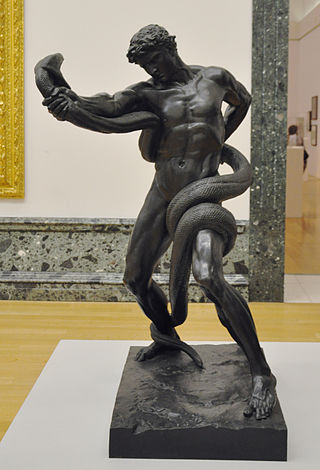
An Athlete Wrestling with a Python was the first of three bronze sculptures produced by the British artist Frederic Leighton. Completed in 1877, the sculpture was a departure for Leighton, and heralded the advent of a new movement, New Sculpture, taking realistic approach to classical models. It has been described as a "sculptural masterpiece" and as "possibly Leighton's greatest contribution to British art". Despite its indebtedness to the Classical tradition, it can be understood as one of the first stirrings of modern sculpture in Britain as well as in Europe. The Athlete was arguably the most influential piece of English sculpture of the 19th century.
The Bath of Psyche is an oil painting by Frederic Leighton, first exhibited in 1890. It is in the collection of Tate Britain.
Crenaia, the Nymph of the Dargle is an oil painting by Frederic Leighton, first exhibited in 1880. It is in the collection of Juan Antonio Pérez Simón.

The Fisherman and the Syren is an oil painting by Frederic Leighton, first exhibited in 1858. It is a composition of two small full-length figures, a mermaid clasping a fisherman round the neck. The picture is in the collection of the Bristol Museum & Art Gallery.

Venus Disrobing for the Bath is an oil painting by Frederic Leighton, first exhibited in 1867.

Actaea, the Nymph of the Shore is an oil painting by Frederic Leighton, first exhibited in 1868.

Winding the Skein is an oil painting by Frederic Leighton, first exhibited in 1878.

Nausicaa is an oil painting by Frederic Leighton, first exhibited in 1878.

The Music Lesson is an oil painting by Frederic Leighton, first exhibited in 1877.

The Syracusan Bride Leading Wild Animals in Procession to the Temple of Diana, also known as A Syracusan Bride Leading Wild Beasts in Procession to the Altar of Diana, is an oil painting by the English artist Frederic Leighton, which was first exhibited, to a favourable reception, at the Royal Academy of Arts in 1866.
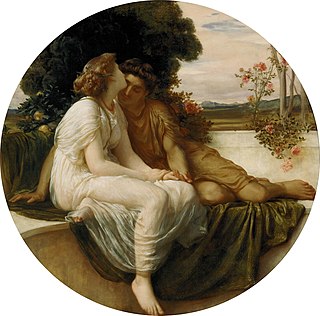
Acme and Septimius is an oil painting by Frederic Leighton, first exhibited in 1868. Leighton took the subject from a love poem by the Roman poet Catullus.

Psamathe is an oil painting by Frederic Leighton, first exhibited in 1880.






















